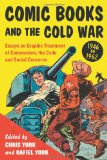As David Hadju documents in his excellent examination of comic books in the 1940s and 1950s, The Ten-Cent Plague, adults saw the genre as contributing to juvenile delinquency and even subverting American values. This uproar, which included U.S. Senate hearings, led to the creation of the Comic Codes Authority in 1954. Yet even before the code, the Cold War often produced comic books that tended to inculcate American values. The methods and influences and explored in Comic Books and the Cold War, 1946-1962: Essays on Graphic Treatment of Communism, the Code and Social Concerns.
 Edited by brothers Chris and Rafiel York, the essays look how comic books of that era weren’t just entertainment and amusement, as those of us who grew up then may have believed. Although occasionally repetitive, the book shows how comic books often reflected government policy and attitudes toward community mores.
Edited by brothers Chris and Rafiel York, the essays look how comic books of that era weren’t just entertainment and amusement, as those of us who grew up then may have believed. Although occasionally repetitive, the book shows how comic books often reflected government policy and attitudes toward community mores.
The essays focus on what comics communicated to and about society during the “Containment” era. Containment was the brainchild of George F. Kennan and became the basis of our foreign policy. At its core, it was predicated on the belief that the U.S. could combat the Soviet Union’s efforts to spread Communism with “a policy of firm containment, designed to confront the Russians with unalterable counter-force at every point where they show signs of encroaching upon he interests of a peaceful and stable world.” But Kennan didn’t believe this effort was limited to foreign policy. “Every courageous and incisive measure to solve internal problems of our own society, to improve self-confidence, discipline, morale and community spirit of our own people, is a diplomatic victory over Moscow,” he said in a telegram from the U.S. Embassy in Moscow.
The domestics aspects of containment are the focus of the essays in Comic Books and the Cold War. While some of the comics told stories of direct confrontation between the forces of good (America) and evil (foreign or other worldly enemies), many were much more subtle or, as we are told repeatedly, metaphoric. For example, Frederick A. Wright’s essay on the Flash comics, “I Can Pass Right Through Solid Matter!” (which actually tells messages are being conveyed “metaphorically” in three consecutive paragraphs), suggests that the bank robbers the Flash might be viewed as “the capitalist fear of communist system’s redistributing the wealth.” Or that a villain’s efforts to freeze the Flash or prevent his movement represents the Cold War restricted the movements of America in foreign policy.
The domestic message is best summarized in Rafiel York’s essay on the Archie comics, “Rebellion in Riverdale.” The comics help the federal government:
promote[] an American lifestyle that was characterized by morality, the family, economic progress and personal fulfillment. The America that would best combat the communist threat was one where men went to work and earned enough money that their wives were able to stay home with the kids in a suburban house stocked with the latest appliances. while focusing on making themselves beautiful. It was an American where people went to church on Sundays, and practiced the morality they learned there the rest of the week. It was an America where people prided themselves on being “normal. It was an America where all teenagers acted like Archie and the Riverdale gang.”
And how did Archie and crew act for the most part? They don’t represent the average teenager but are “typical only of the kind of teenager that most adults want to have around.”
Comic Books and the Cold War makes clear that even if the comics of that era weren’t overtly intended to inculcate “American values,” they certainly reflected much of the thinking of the era. Thus, we see battles for dominance and containment in space, threats of espionage, the risk to girls of sexually errant behavior, both the promise and threat of science and even flat out “godless Commies.” Still, there was a bit of subversion. In her essay “The Amazon Mystique,” Ruth McClelland-Nugent suggests Wonder Woman was an early vehicle of nascent feminism while Diana Green suggests EC Comics occasionally dealt with GLBTQ themses. Even characters in Archie occasionally break traditional gender roles or profit from arguably immoral behavior.
Focusing as it does on a specific era and relatively narrow themes, Comic Books and the Cold War does not intend to be and is far short of The Ten-Cent Plague. It often has more of an academic tone than the casual reader may want and some of the essays, frankly, don’t really tell us a lot. Still, it provides interesting perspective on the role of comic books in shaping public opinion and trying to mold young readers during the height of the Cold War.
Primers and comics underscored the lurking threat communists posed to Americans and introduced their young audience to the anxieties and paranoia of the era.
Peter Lee, “Decrypting Espionage Comic Books in 1960s America,”
Comic Books and the Cold War, 1946-1962







